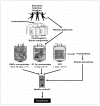Cell-derived microparticles in stored blood products: innocent-bystanders or effective mediators of post-transfusion reactions?
- PMID: 22890265
- PMCID: PMC3418623
- DOI: 10.2450/2012.006S
Cell-derived microparticles in stored blood products: innocent-bystanders or effective mediators of post-transfusion reactions?
Figures

Similar articles
-
The effect of platelet-derived microparticles in stored apheresis platelet concentrates on polymorphonuclear leucocyte respiratory burst.Vox Sang. 2014 Apr;106(3):234-41. doi: 10.1111/vox.12092. Epub 2013 Oct 21. Vox Sang. 2014. PMID: 24138005
-
Microparticles from stored red blood cells enhance procoagulant and proinflammatory activity.Transfusion. 2017 Nov;57(11):2701-2711. doi: 10.1111/trf.14268. Epub 2017 Aug 2. Transfusion. 2017. PMID: 28766731
-
Analysis of leucocyte antibodies, cytokines, lysophospholipids and cell microparticles in blood components implicated in post-transfusion reactions with dyspnoea.Vox Sang. 2015 Jan;108(1):27-36. doi: 10.1111/vox.12190. Epub 2014 Aug 18. Vox Sang. 2015. PMID: 25134637 Clinical Trial.
-
Microparticles in stored red blood cells: submicron clotting bombs?Blood Transfus. 2010 Jun;8 Suppl 3(Suppl 3):s31-8. doi: 10.2450/2010.006S. Blood Transfus. 2010. PMID: 20606747 Free PMC article. Review. No abstract available.
-
Pathophysiology of febrile nonhemolytic transfusion reactions.Curr Opin Hematol. 1999 Nov;6(6):420-6. doi: 10.1097/00062752-199911000-00012. Curr Opin Hematol. 1999. PMID: 10546797 Review.
Cited by
-
Platelet Inflammatory Response to Stress.Front Immunol. 2019 Jun 28;10:1478. doi: 10.3389/fimmu.2019.01478. eCollection 2019. Front Immunol. 2019. PMID: 31316518 Free PMC article. Review.
-
The involvement of cation leaks in the storage lesion of red blood cells.Front Physiol. 2014 Jun 17;5:214. doi: 10.3389/fphys.2014.00214. eCollection 2014. Front Physiol. 2014. PMID: 24987374 Free PMC article. Review.
-
Plasma Membrane Lipid Domains as Platforms for Vesicle Biogenesis and Shedding?Biomolecules. 2018 Sep 14;8(3):94. doi: 10.3390/biom8030094. Biomolecules. 2018. PMID: 30223513 Free PMC article. Review.
-
Leucoreduction of blood components: an effective way to increase blood safety?Blood Transfus. 2016 May;14(2):214-27. doi: 10.2450/2015.0154-15. Epub 2015 Dec 16. Blood Transfus. 2016. PMID: 26710353 Free PMC article. Review.
-
Effect of Irradiation on Microparticles in Red Blood Cell Concentrates.Ann Lab Med. 2016 Jul;36(4):362-6. doi: 10.3343/alm.2016.36.4.362. Ann Lab Med. 2016. PMID: 27139610 Free PMC article.
References
-
- De Maio A. Extracellular heat shock proteins, cellular export vesicles, and the Stress Observation System: a form of communication during injury, infection, and cell damage. It is never known how far a controversial finding will go! Dedicated to Ferruccio Ritossa. Cell Stress Chaperones. 2011;16(3):235–49. - PMC - PubMed
-
- Jin M, Drwal G, Bourgeois T, et al. Distinct proteome features of plasma microparticles. Proteomics. 2005;5:1940–52. - PubMed
-
- Mause SF, Weber C. Microparticles: protagonists of a novel communication network for intercellular information exchange. Circ Res. 2010;107:1047–57. - PubMed
Publication types
MeSH terms
LinkOut - more resources
Full Text Sources
Medical
